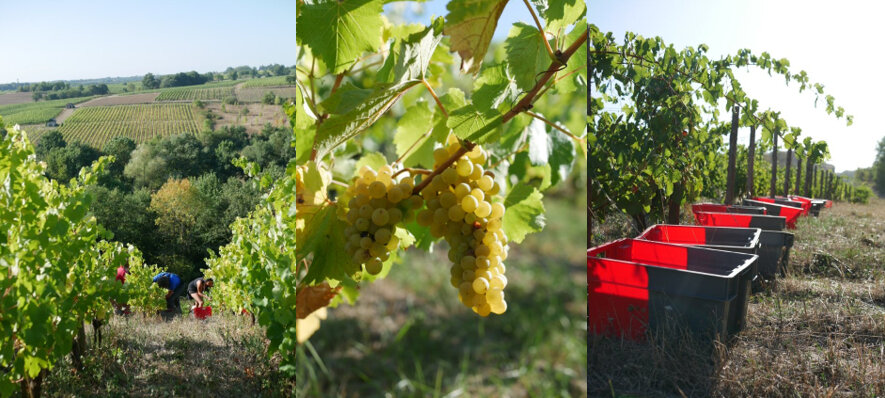Saint-Lambert du Lattay, October 2019
Dear friends,
Now that the 2019 harvest is behind us and that our barrels are "gurgling" nicely in the cellar, we wanted to take a moment to share with you the highlights of this new vintage, the second since last year’s transmission.
Let’s go straight to the point: Mother Nature has put us to test this year! This after having made us a real "welcome gift" last year with the 2018 vintage, exceptional in all respects (the most productive in the last 10 years and done fully under the sun until the end of the harvest, late October).
Complete change of scenario for 2019!
◦ ◦ ◦
From the very beginning of the year we knew that the harvest would be complicated: the month of February counted more than 15 days of almost summer temperatures, which triggered suddenly the rise of sap in the vines and caused a bud burst. During the following weeks the weather was mild with a complete absence of winter, favouring the development of buds and the early formation of new branches.
Nature teaching us a lesson
Then it only took one night of frost, on 4 April, to devastate our vineyard to more than 80%. The first rays of the sun burnt on foot these "thrusts of life", still so fragile... Paradoxically, our best exposed terroirs, the earliest (in the Quarts-de-Chaume sector and Les Treilles, in particular) were hit the hardest...
Tough life, that of a winemaker... But the vines are resourceful, and second-generation buds quickly appeared! Unfortunately, two new frost episodes hit Anjou in late April and early May, 72 hours apart, which could have been fateful for the vineyard...
But we fought hard to protect them: the whole team battled for 2 nights to fight against the cold, by placing heaters in the plots or creating walls of smoke by burning haystacks.
Epic battle(s) against frost… unfortunately with limited results: we lost 80% of the harvest in one single night, on 4 April 2019.
Our efforts were not in vain: we "saved" Les Ruchères (a hillside plot located in Savennières at the bottom of La Roche-aux-Moines on an exceptional slate-schist soil), as well as Les Bonnes Blanches (a plot alongside the Layon river, on shale and clay soils in Saint Lambert du Lattay).
No rest for the brave
But Mother Nature was not done with our vines yet ... Summer was another challenge for our vineyards, which are fortunately very robust: a heat wave settled for long weeks, causing water stress and sometimes even burns on the bunches. Fortunately, the rains of mid- and late August have lowered temperatures, relaxed the grapes and perhaps allowed us to avoid the worst.
The only reason for us to rejoice: the pressure of diseases was minimal this year, and we hardly had to treat our vines. The result is an excellent health condition, with beautiful grapes harvested under the September sun.
Beautiful harvest day on Coteau des Treilles.
The challenge this year was not to be overtaken by the rise in sugar content, extremely fast because of the low load on each foot. Like last year, we followed an extremely precise monitoring protocol for the maturity at the level of each single plot.
We have therefore managed to harvest each plot at its optimum maturity, and we think we will create dry wines which will be all in finesse, with pretty depths and the characteristic tension of great terroirs’ Chenin.
The harvest itself was brief, less than fifteen days, with a team of twenty people particularly close and enthusiastic this year.
The few Chenin grapes we had this year were in perfect sanitary conditions.
Prime time!
We gave the first shots of pruner on Thursday, 12 September, starting with a first stint in Les Rouères on the Quarts-de-Chaume sector, then
Les Gaudrets above the village of Savennières, ...
The mythical Coteau des Treilles, ...
Les Quarts and Le Veau plots to complete our trilogy of terroirs on Quarts-de-Chaume,
Our other "monopole", Le Clos des Ruchères ...
... and then we finished (as every year) by our great Northern-exposed terroir: Le Clos des Bonnes Blanches.
Our Chenin grapes were ripe to perfection, truly “al dente” this year
Overall, we collected very healthy grapes and found only a tiny amount of clusters affected by decay. Not surprisingly, the yields were very low: 12 hectolitres per hectare (when we reach, in a good year, 25 to 30 hectolitres per hectare).
But overall, the juice yield was higher than expected, and the whole team is delighted! We are notably happy to be able to vinify each of our single plots in 2019, even if some will be limited to a few barrels only.
All the diversity of our great terroirs of Anjou Noir will therefore be able to express itself this year again!
◦ ◦ ◦
Another reason to rejoice: the cellar is full of the historical 2018 vintage! We continue patiently the ageing process (up to three years) and will start bottling at the end of this year our first cuvées, the first under the "Belargus" label.
In short, some beautiful moments of tasting and sharing to come with you... So, we are awaiting your visit at the Domaine to talk about all this, glass in hand! ;-)
Team Belargus





